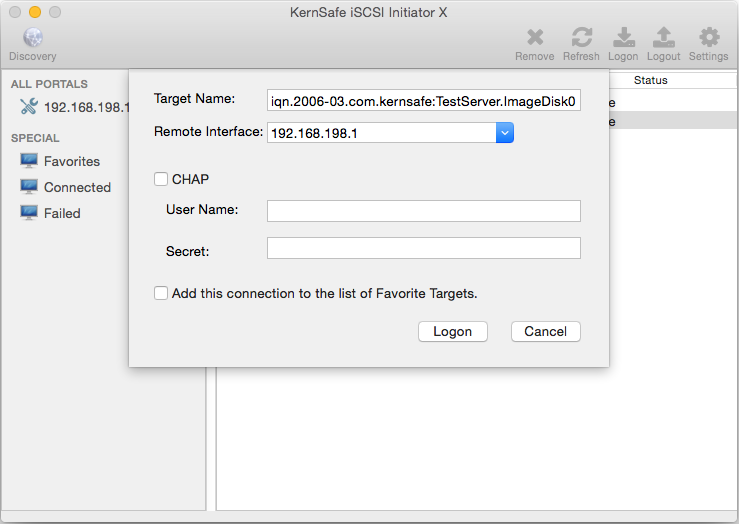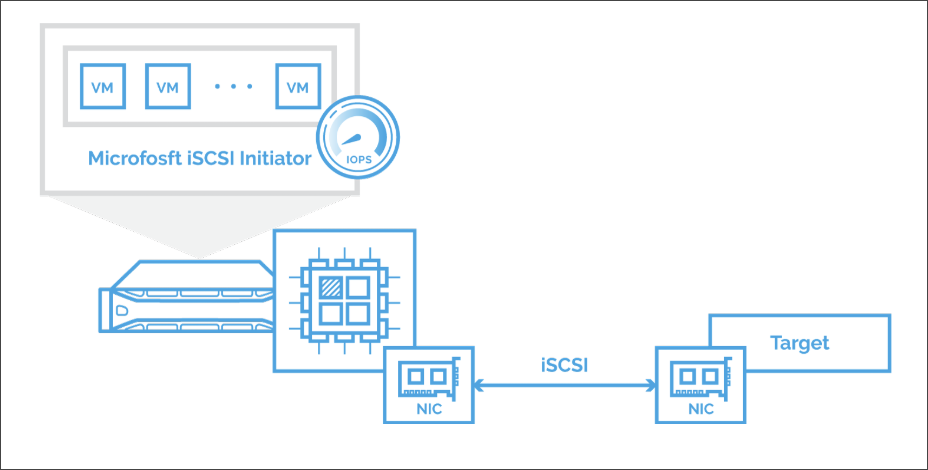
- Synology Iscsi Mac
- Free Iscsi Initiator For Mac
iSCSI is a network storage protocol that allows sending and receiving of SCSI commands over a TCP/IP network. This allows you to leverage Ethernet, a low cost network medium to get SAN performance and network based storage. While you can use pretty much any Ethernet switch, I’d recommend that if you’re going to use iSCSI that you dedicate a switch to it, or use quality switches and build a dedicated VLAN for your iSCSI traffic.Recently, I’ve recently been seeing a lot of traffic about whether or not you can use iSCSI with Mac OS X. The answer, yes. As with Xsan, to get started with iSCSI you’ll need an initiator and a target. Studio Network Solutions (SNS) provides a software-based iSCSI initiator called globalSAN that can be downloaded and used free of charge from their site. Alternatively you can also look into the Atto Xtend SAN, which runs about $200 for 1 user with volumes discount slashing the prices to about $90 for 100 users. Software based initiators will use the CPU of your system and a built-in or third party standard Ethernet port, but you can also buy a dedicated card which will offload the processing power to the card, which in some cases will be required for various performance reasons. For the purpose of this article we’re going to use the SNS globalSAN software.For the purposes of this howto, we’re using the free version of software called Starwind from RocketDivision. However, we’ve also tested LeftHand, Isilon, OpenFiler, iSCSI Target (from Microsoft) and many others (including dozens of appliances) with the Mac. So for starters, fire up your iSCSI storage and share it out. Next, extract the installer as seen in the globalSAN installer screenshot.Next, launch the installer and click on the Continue button at the Welcome screen.At the Software License Agreement screen, read the licensing agreement and then click on the Continue button if you agree to the terms.At the uninstall screen, click on continue. If you later need to uninstall the software you would re-run this installer and click on the Uninstall button.At the Standard Install screen you can click on the Custom Install button to allow you to choose which packages within the metapackage to install. It is best to leave them all checked and then click on the Continue button.Provided everything installs properly you will next be at the Installation Completed Successfully screen. Here, click on Restart and then log back into the system when it comes back online.Once you are logged back in, open System Preferences and you’ll see the new System Preference for globalSAN iSCSI.If you click on the globalSAN System Preference you’ll be able to add your first portal. Each share will have a unique IP and be referenced as a portal. Click on the add icon (+) to add your first portal.At the dialog box, type in the IP address of your iSCSI target and the port number, which defaults to 3260 for a majority of the products you may use.If you require authentication to your target then click on the Advanced… button and enter the pertinent information (Kerberos is not yet supported as an authentication method but CHAP is).You can also click on the IPSec tab if you use IPSec for authentication on your targets.Click OK to add your portal and you will be taken back to the Portals tab of the globalSAN System Preference. Here you should see your portal listed. If you don’t, click on the Refresh button.Now that you have your portal populated, click on the Targets tab and you should see the storage listed. Click on it and then click on the Log On button to initiate your session into the storage. At this point, it will mount on the Desktop (provided you have already given it a file system) and you will be able to use it as you would any other storage. You can check the box for Peristent if you would like to have the volume always mounted on the system.If you click on the Sessions tab then you will be able to look at various statistics about your storage including the LUN identifier and disk name.If you don’t yet have a file system on the storage then you can go ahead and open Disk Utility and you will see the storage listed there, click on it, click on the Partition tab and you will then be able to give it a file system.So it’s pretty easy to use iSCSI with Mac OS X. We didn’t have to open Terminal or do anything crazy in the least. It just works and while it’s not going to be as fast as something like fiber channel, it also doesn’t come with the costly infrastructure requirements that fiber channel comes with. The LUNs can be accessed by multiple hosts provided that the file system supports that. However, HFS+ does not support iSCSI, nor do any of the current file systems for the Mac that we’ve tested other than acfs (Apple Clustered File System)/cvfs, the file system for Xsan.
The UNH-iSCSI project consists of software implementations of Initiator and Target loadable modules for the IETF Networking (SAN) protocol iSCSI RFC3720 with support for iSER RFC5046. 1 Review Downloads: 0 This Week Last Update: 2013-04-17 See Project. ISCSI is not natively supported on macOS. You need to use 3rd party software. The best one that I have used (but it costs $$$) is the one from globalSAN – Allan May 8 '18 at 7:14.
Free iSCSI Initiator Online Help for Apple Mac OS X Free iSCSI Initiator Online Help for Apple Mac OS X, this document gives you step-by-step of using iSCSI initiator on Mac OS X. KERNSAFE - iSCSI SAN Software and Storage Virtualization. Record the iSCSI initiator local adapter (MAC) address. Use the appropriate method for your iSCSI initiator adapter type: Ethernet NIC Look for the word MAC on the label. Record the address information in pairs of digits in work sheet items RS13 and RS17. Note that the same adapter address is used for both the SCSI and LAN interfaces.
To access iSCSI targets, your ESXi Gun inventory software for mac download. host uses iSCSI initiators.


The folks at Studio Network Solutions has made their globalSAN iSCSI Initiator available free for download subject to their EULA. Click on the icon below to open their download page. You’ll need to reboot the Mac after the installation. Step 2: Setup globalSAN iSCSI Initiator to connect to the iSCSI target.
The initiator is a software or hardware installed on your ESXi host. Neo geo bios files. The iSCSI initiator originates communication between your host and an external iSCSI storage system and sends data to the storage system.
In the ESXi environment, iSCSI adapters configured on your host play the role of initiators. ESXi supports several types of iSCSI adapters.
For information on configuring and using iSCSI adapters, see Configuring iSCSI Adapters and Storage.
Software iSCSI Adapter
A software iSCSI adapter is a VMware code built into the VMkernel. Full service game download. Using the software iSCSI adapter, your host can connect to the iSCSI storage device through standard network adapters. The software iSCSI adapter handles iSCSI processing while communicating with the network adapter. With the software iSCSI adapter, you can use iSCSI technology without purchasing specialized hardware.
Hardware iSCSI Adapter

A hardware iSCSI adapter is a third-party adapter that offloads iSCSI and network processing from your host. Hardware iSCSI adapters are divided into categories.

- Dependent Hardware iSCSI Adapter
- Depends on VMware networking, and iSCSI configuration and management interfaces provided by VMware.
- This type of adapter can be a card that presents a standard network adapter and iSCSI offload functionality for the same port. The iSCSI offload functionality depends on the host's network configuration to obtain the IP, MAC, and other parameters used for iSCSI sessions. An example of a dependent adapter is the iSCSI licensed Broadcom 5709 NIC.
Synology Iscsi Mac
- Independent Hardware iSCSI Adapter
- Implements its own networking and iSCSI configuration and management interfaces.
- Typically, an independent hardware iSCSI adapter is a card that either presents only iSCSI offload functionality or iSCSI offload functionality and standard NIC functionality. The iSCSI offload functionality has independent configuration management that assigns the IP, MAC, and other parameters used for the iSCSI sessions. An example of an independent adapter is the QLogic QLA4052 adapter.
Free Iscsi Initiator For Mac
Hardware iSCSI adapters might need to be licensed. Otherwise, they might not appear in the client or vSphere CLI. Contact your vendor for licensing information.





